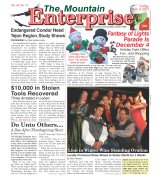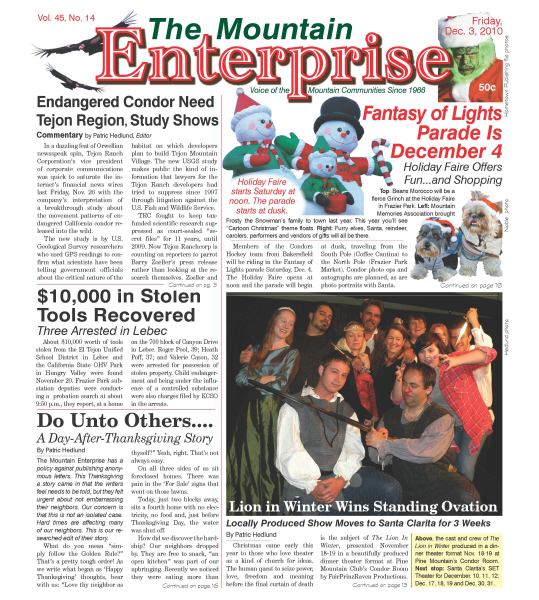![A California condor [Rick Throckmorton photo]](https://mountainenterprise.com/fds/images/story/fs_7872.jpg)
A California condor [Rick Throckmorton photo]
Commentary by Patric Hedlund, Editor
In a dazzling feat of Orwellian newsspeak spin, Tejon Ranch Corporation‘s vice president of corporate communications was quick to saturate the internet’s financial news wires last Friday, Nov. 26 with the company’s interpretation of a breakthrough study about the movement patterns of endangered California condor released into the wild.
The new study is by U.S. Geological Survey researchers who used GPS readings to confirm what scientists have been telling government officials about the critical nature of the habitat on which developers plan to build Tejon Mountain Village. The new USGS study makes public the kind of information that lawyers for the Tejon Ranch developers had tried to suppress since 1997 through litigation against the U.S. Fish and Wildlife Service.
TRC fought to keep tax-funded scientific research suppressed as court-sealed “secret files” for 11 years, until 2009. Now Tejon Ranchcorp is counting on reporters to parrot Barry Zoeller’s press release rather than looking at the research themselves. Zoeller and TRC’s lawyers are professionals with jobs and stock options who do what they are paid to do, and they do it very well. We respect their skill.
Fortunately for the public’s right to know, however, the new study authored by Matthew Johnson, Jeffrey Kern and Susan M. Haig of the USGS unchains facts from the tactical politics that guide the judgment of TRC’s board of directors and, too often, the state’s politicians.
“The most striking result from our analysis was the recolonization of the Tejon Mountain Village Specific Plan, California Condor Study Area and Tejon Ranch management units during 2008,” the scientists report.
Despite efforts by TRC to keep North America’s largest land bird from their property, and despite suspicious deaths of several of the endangered birds that had visited the TRC range three years ago, by 2009 a full 100 percent of the released birds wearing radio transmitters had rediscovered and recolonized the condors’ historical critical habitat, much of which overlaps where TRC wants to build 3,450 homes and six resort hotels. That specific land has been called a “linchpin” for the species’ survival in the wild by the dean of California condor researchers, Dr. Noel Snyder.
In an interview last year, he said the critical habitat area enables the soaring birds— which may forage about 100 miles in a day—to access their southern Sierra Nevada habitat. They need access to the full range of habitat to live as fully wild birds again, rather than “on the dole,” as Snyder refers to feeding stations. He said that the soaring habits of the condor make thermal patterns above some of the Tejon Ranch elevations critical to their ability to lift high enough to soar into the Sierra Nevada range.
Zoeller’s press release applauds the company’s planned dedication of 178,000 acres to the Tejon Ranch Conservancy and the November 18 decision by California’s Wildlife Conservation Board to purchase conservation easements from Tejon Ranchcorp for $15.8 million. But concerned condor scientists still say that—for the endangered California condor— it is not the right land that is being saved.
Referring to the USGS’ data showing that 100 percent of the birds rediscovered the Tejon Mountain Village region, David Clendenen (who was lead biologist for USFWS in charge of condor field studies from 1994-1997) said in an interview Wednesday, Dec. 1, “The birds have always used that site, it is powerful evidence that not only historical wild birds but also the reintroduced birds [born in captivity] have come back to the same spot. That shows that the critical habitat designations are meaningful.”
This is part of the December 03, 2010 online edition of The Mountain Enterprise.
Have an opinion on this matter? We'd like to hear from you.


